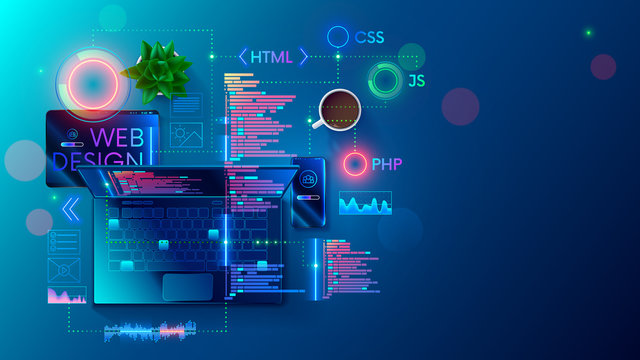Aligned Position Web Design: Your One-Stop Solution for Innovative Website Design and Development
The Most Effective Sorts Of Website Design to Improve Individual Experience and Interaction
In the ever-evolving landscape of digital interaction, the efficiency of website design significantly impacts individual experience and engagement. Different style techniques, such as minimal, responsive, and interactive formats, each deal distinct advantages that can accommodate varied user demands. Understanding which kinds of website design ideal serve these objectives can be pivotal for companies aiming to boost client complete satisfaction and retention. However, the concern continues to be: which design aspects absolutely resonate with individuals and foster meaningful engagement? The exploration of these principles discloses vital understandings that may redefine your method to Web layout.
Minimalist Web Layout
As electronic landscapes become progressively chaotic, minimal Web layout has become a powerful method to boosting individual experience. This layout philosophy focuses on simplicity, concentrating on necessary components while getting rid of unneeded diversions. By making use of sufficient white room, straightforward navigating, and a restricted shade combination, minimalist style fosters clarity and routes user focus to essential material.
The core principle of minimal Web layout is to create a smooth interaction for customers. By decreasing cognitive tons, individuals can swiftly comprehend information without really feeling bewildered. This straight technique not only improves functionality but additionally urges involvement, as site visitors are a lot more likely to explore a website that is easy and aesthetically appealing to browse.
Additionally, minimalist style usually stresses typography and images, using these aspects tactically to communicate messages properly. In significance, minimalist Web style is not simply a pattern; it is a thoughtful approach that recognizes the relevance of user-centered style.
Receptive Website Design
In today's varied digital setting, responsive Web design has come to be important for developing a smooth individual experience across a plethora of devices. As customers gain access to internet sites on smartphones, laptop computers, tablet computers, and desktops, the ability of an internet site to adapt its layout and content to various display sizes and resolutions is essential.
Receptive website design utilizes adaptable grids, images, and CSS media questions to make sure that Web content is provided ideally, no matter the tool used. This strategy not just enhances the aesthetic charm of a site however additionally significantly boosts use. Customers are most likely to engage with a site that uses a regular experience, as it gets rid of the disappointment of needing to focus or scroll exceedingly.
Furthermore, search engines, consisting of Google, focus on mobile-friendly internet sites in search rankings. By embracing responsive style, businesses can enhance their presence and get to a more comprehensive target market. This technique also simplifies website maintenance, as a single variation of the site can accommodate all tools, decreasing the need for several variations. In summary, receptive website design is an essential practice that enhances user experience, involvement, and overall complete satisfaction.
Interactive Web Layout
Receptive website design prepares for boosting user experience, however interactive Web style takes this a step better by engaging customers in an extra vibrant way - Aligned Position Web Design. By integrating elements such as animations, clickable models, and real-time feedback, interactive Web layout mesmerizes individuals, attracting them right into a richer surfing experience
This approach not just fosters interaction however likewise encourages users to explore content proactively as opposed to passively eating it. Methods such as gamification, where users earn benefits for completing jobs, can significantly improve the moment invested on a site and enhance overall contentment. Additionally, interactive features can simplify complicated info, making it a lot more enjoyable and digestible.

Integrating interactive design elements can likewise result in greater conversion prices, as customers are most likely to engage advice with a website that actively involves them. Aligned Position Web Design. Ultimately, interactive website design transforms user experiences right into remarkable journeys, guaranteeing that site visitors return time after time
Apartment Style
Defined by its minimalistic technique, level style emphasizes simplicity and capability, stripping away unneeded aspects and concentrating on vital attributes. This style approach prioritizes use, making sure that individuals can browse user interfaces easily and efficiency. By utilizing about his a clean aesthetic, level style removes the mess typically located in a lot more ornate designs, thus improving user concentrate on web content and functionality.
The characteristic of level style hinges on its use bold colors, easy typography, and geometric shapes. These components contribute to an aesthetically appealing user interface that is both modern and friendly. In addition, flat layout promotes a feeling of clearness, enabling customers to determine vital actions and info without diversion.
Moreover, flat layout is specifically reliable in receptive Web layout, as its simpleness equates well across numerous gadgets and screen sizes. By focusing on vital attributes, flat style not only satisfies user needs however likewise urges smooth communication, making it a crucial component of reliable Web design techniques.
Flexible Web Design
Adaptive Web layout personalizes the individual experience by producing several repaired formats customized to different screen dimensions and tools. Unlike responsive layout, which fluidly adjusts a single format, adaptive style uses distinct layouts for certain breakpoints, ensuring optimum discussion on different platforms. This method allows developers to focus on the special qualities of each tool, boosting usability by supplying specifically what users require based upon their context.
Among the main benefits of adaptive Web design is its capability to maximize tons times and performance. By serving customized web content and photos that fit the individual's device, internet sites can reduce information use and boost loading speeds. This is specifically helpful for individuals with slower links or minimal information plans.

Additionally, adaptive design promotes an extra regular and regulated branding experience. Because developers produce several designs, they can guarantee that the aesthetic components align with the brand name's identity across different systems - Aligned Position Web Design. This leads to a cohesive user experience, boosting involvement and advertising individual retention
Conclusion
Minimalist style fosters clearness and focus, while receptive style makes certain adaptability across numerous tools, promoting accessibility. Jointly, these design approaches contribute to the creation of easy to use atmospheres that not only improve satisfaction yet also drive higher conversion prices, emphasizing their critical importance in contemporary Web layout techniques.

Minimalist layout cultivates clearness and focus, while receptive design makes sure flexibility across different tools, promoting availability. Jointly, these layout approaches contribute to the creation of straightforward environments that not just boost complete satisfaction yet additionally drive greater conversion prices, highlighting their essential value in contemporary Web design strategies.